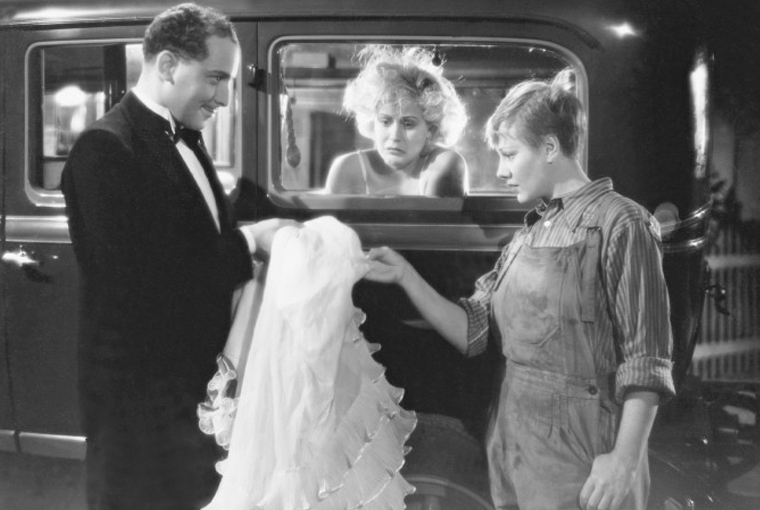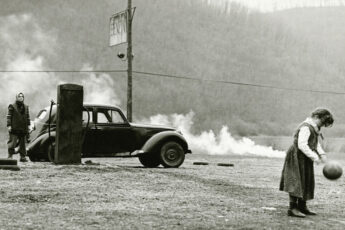Biting the Hand that Feeds
Hermann Kosterlitz’s Peter (1934)
Vol. 27 (March 2013) by Colette de Castro
Peter, a Hungarian/Austrian co-production directed by Hermann Kosterlitz, featured as part of the Retrospective at the Berlinale this year. The eponymous hero is in fact a young woman called Eva. Eva, a young maverick, is extremely intelligent and constantly cheery. While busking with her grandfather in the courtyard of an apartment block, she is forced to change clothes with a criminal on the run. He takes her dress and leaves her in oversized trousers, shirt and cap.
The opening scene shows the grandfather and granddaughter being evicted from their apartment. We see a courtyard with chairs and tables lying on the ground. In the background we hear the sound of a girl’s voice pleading with someone: “No, no, not Napoleon” she exclaims. But two seconds later the portrait of Napoleon hurtles towards the ground. Then comes a large vase which her grandfather, appearing suddenly, catches adroitly. A pretty face peeks out the window: a girl of around 15 years old. She smiles happily at her grandfather, asking if he caught it. He holds up the vase proudly, but just then a shovel is thrown out the window, breaking the vase into many pieces. The comic timing of the film is exquisite and it’s easy to forget that we’re watching something made under difficult circumstances.
Hungarian actress Franziska Gaal, more easily recognized on the cabaret stage than on the cinema screen, carefully crafts the character of Eva, disguised as a boy called Peter. Awaiting a court trial, Eva tests out her new-found boyhood by mimicking a young scoundrel sitting opposite her. She carefully copies his grimaces, spitting and sneering to perfection. When she realizes just before the trial that his face is covered in freckles, she finds an unlikely and hilarious way to create freckles of her own.
German director Hermann Kosterlitz changed his name to Henry Koster when he moved to America in the 1930s. He made this film in Hungary as a last ditch attempt to have his exile rescinded. At the Berlinale this year the Retrospective section was named “The Weimar Touch”, and was dedicated to showing how Weimar cinema influenced filmmaking from all over the world after 1933, especially in America.
Her grandfather being a dysfunctional alcoholic, it is up to Eva to find them money and a place to live. On finding some coins in her jacket pocket, she gleefully buys newspapers off the back of a truck. Still disguised as a boy, she stands in front of a hotel to try and sell the papers, slyly eavesdropping on the sales pitch of the boy opposite her: “Man murders his own mother”. She copies this, but when the catchphrase doesn’t work, her advertising pitch gradually degenerates until the line “Two-year old boy beats up his whole family”, catching general attention. Her papers start selling like hotcakes, until a suspicious doctor leafs through the paper and comes back to denounce her scam. Thus arrives the crux of the plot, involving a court scene, a debt and a new job.
Now that the hustle and bustle of the Berlinale has passed, we can reflect on the general indignation at the quality of the selection for the competition this year’s festival caused among journalists. Several writers claimed that the festival does not deserve it’s reputation as a top European film festival – it is usually considered third after Cannes and Venice. This is not a new problem: “As a rule”, Jonathan Romney wrote for Sight and Sound in 2011, “critics have learned from bitter experience not to expect revelations from Berlin, especially not from the flaccid and usually middle-brow competition selection.”
“Biting the hand that feeds” is an essential part of a film critic’s job. Usually this job is done one film at a time when a particular new film disappoints a reviewer. Criticizing a whole festival and the films in it is another matter. Yet it is difficult to compare the competitions of two such different festivals as Berlin and Cannes. One of the crucial differences though is the fact that in Cannes very few films are open to the general public, and never the competition films. The Berlinale on the other hand, is a festival which is essentially public, and the many different sections and pleasant surprises often make up for the sometimes low quality (cf. Cannes) of the competition films.
Furthermore, the Berlinale is known for choosing films with a political angle. Take the Panorama category for example, famous for it’s films dealing with gay, lesbian and transgendered issues. Maybe the films in this category are not always the most aesthetically pleasing or sophisticated. But, as with Peter, these are the films that we will look back at in eighty years and say that they were unusual for their time. Film style goes out of date quickly, (with some undeniable exceptions) and it is only experts who can tell when a historical film is slightly aesthetically different from it’s contemporaries. Ideas on the other hand, live on, and it will tend to be these which we will look back upon as trailblazing. In the thirties that concept was a girl in drag. Who knows what it will be tomorrow.
The retrospective is arguably the best section at the Berlinale. It is solid, pulled together carefully and of top quality. Rainer Rother, its director, clearly has a good eye. It is also rather modest, with most of the screenings being held at the small but quaint Zeughauskino at one end of the Unter den Linden. The retrospective cleverly combines several different angles, while successfully exploiting the well-organized archives situated in the city of Berlin. Peter is just one example of how a festival’s film doesn’t need to be new to be a discovery.




Leave a Comment